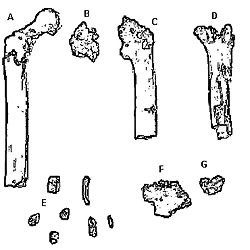
Orrorin tugenensis is a postulated early species of Homininae, estimated at 6.1 to 5.7 million years (Ma) and discovered in 2000. It is not confirmed how Orrorin is related to modern humans. Its discovery was an argument against the hypothesis that australopithecines are human ancestors, as much as it still remains the most prevalent hypothesis of human evolution as of 2012. The name of genus Orrorin (plural Orroriek) means "original man" in Tugen, and the name of the only classified species, O. tugenensis, derives from Tugen Hills in Kenya, where the first fossil was found in 2000. As of 2007, 20 fossils of the species have been found.
For more information, click here. Or, Try these sources:
- CogWeb. "Orrorin Tugenensis: Pushing back the hominin line". UCLA. Retrieved December 1, 2010. Can be read here.
- Haviland, William A.; Prins, Harald E. L.; Walrath, Dana; McBride, Bunny (2007). Evolution and prehistory: the human challenge. Cengage Learning. ISBN 0-495-38190-X. Can be read here.
- Henke, Winfried (2007). Henke, Winfried; Hardt, Thorolf; Tattersall, Ian, eds. Handbook of paleoanthropology: Phylogeny of hominids. Springer. pp. 1527–9. ISBN 978-3-540-32474-4. Can be read here.